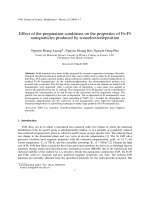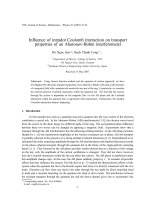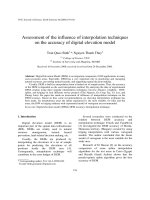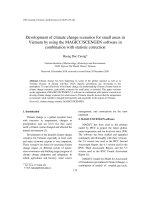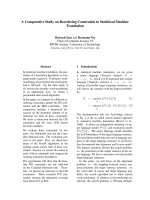Báo cáo " Assessment of climate change impacts on salinity intrusion in Hong-Thai Binh and Dong Nai river basins " pptx
Bạn đang xem bản rút gọn của tài liệu. Xem và tải ngay bản đầy đủ của tài liệu tại đây (392.62 KB, 8 trang )
VNU Journal of Science, Earth Sciences 27 (2011) 54-61
54
Assessment of climate change impacts on salinity intrusion in
Hong-Thai Binh and Dong Nai river basins
Tran Hong Thai, Tran Thi Van*
Vietnam Institute of Meteorology, Hydrology and Environment,
23/62 Nguyen Chi Thanh, Hanoi, Vietnam
Received 3 January 2011; received in revised form 18 January 2011
Abstract. Climate change (CC) is a global problem that not only
a
ff
ects the developed countries
but also the developing ones as Vietnam. With a coastal line of approximately 3,260 km, Vietnam
is expected to be affected considerably by climate change including salinity intrusion. Through the
assessment
of
impacts
of
climate change on water resource in Hong-Thai Binh and Dong Nai river
basins which located in two key economic zones, in the paper a general picture of
impacts of
climate change on salinity intrusion in Vietnam is presented, where MIKE 11 was used for Hong –
Thai Binh basin and HydroGIS for Dong Nai basin. The study gives out some results of salinity
intrusion in the two basins according to three climate change scenarios in three typical years: 2030,
2050, and 2100. Finally, both the short and long terms adaptation measures to salinity intrusion
caused by climate change in Vietnam are summarized.
Keywords: Climate change, salinity intrusion, Hong-Thai Binh river, Dong Nai river.
1. Introduction
∗
During the past 50 years, in Vietnam, the
average temperature has increased by about 0.7
0
C and sea level has risen by about 20cm.
According to the forecast of Ministry of Natural
Resources and Environment, by 2100, sea
levels will rise up to 1 m, temperature increases
by about 3°C. Vietnam has a long coastline of
3,260 km and 75% of the population lives in
coastal areas, so it may be affected seriously by
climate change. According to calculations, if
sea level rises a meter, about 40 thousands km
2
of flat plain in Vietnam will be flooded every
year, of which 90% of the provinces of Cuu
Long River Delta be almost completely
flooded. Hong – Thai Binh and Dong Nai river
basins are two major basins located in two key
_______
∗
Corresponding author. Tel.: 84-4-37756201
E-mail:
economic zones of the country with large
coastal area, may seriously be impacted by sea
level rise.
One of the impacts of climate change and
sea level rise is salinity intrusion. Therefore, in
this paper, the effects of climate change on
salinity intrusion are presented.
Salinity intrusion is a natural phenomenon
occurring in the lands, estuaries, and aquifers
being adjacent to the sea. The main cause of
salinity intrusion is a difference of flow energy
(both potential and kinetic energy) as well as of
current density between freshwater and
saltwater. There are many factors affecting the
salinity intrusion: discharge and river flow
periods, topography, morphology, river bed
slope, tides on the sea, wind velocity and
direction, water temperature, the friction on the
flow, etc.
T.H. Thai, T.T. Van / VNU Journal of Science, Earth Sciences 27 (2011) 54-61
55
a) Hong - Thai Binh river basin. b) Dong Nai river basin
Figure 1. Maps of two studied basins.
2. Study method
2.1. Methodology
Many studies on the process of salinity
intrusion into the mainland have been
conducted. However, in Vietnam two major
methods are used that are statistical and
mathematical model ones. This article, some
research results of the process of saline
intrusion impacted by climate change applying
mathematical models are presented. A
calculation schema is showed in Figure 2.
Figure 2. Calculation schema of salinity intrusion under the impacts of climate change.
-
Topographic data
-Meteorological,
hydrological and tidal data
- Data of water resources
and irrigation systems
Calibration
Verificatio
n
Hydraulic model
Transmission
–
Diffusion model
Calculation results of
saline intrusion under
effects of climate
change
Salinity data
for simulation
in baseline
Climate change
- Increasing sea water
level
- Changed discharge
under effects of climate
change
- Salinity parameters
under effects of climate
change
Calibration
Verification
T.H. Thai, T.T. Van / VNU Journal of Science, Earth Sciences 27 (2011) 54-61
56
2.2. Applied tools
The MIKE 11 model was applied for Hong-
Thai Binh river basin and HydroGIS model for
Dong Nai river basin to calculate salinity
intrusion under climate change scenarios.
Application of mathematical models to
predict saline intrusion was carried out as
follow:
- Set up a hydraulic network for the basins
(Figure 3);
- Calibration and verification of hydraulic
model [1, 2];
- Calibration and verification of salinity
intrusion model (Figure 4 and 5) [1, 2];
- Prediction of boundaries and saline
intrusion under climate change and sea level
scenarios.
a) Hong-Thai Binh river basin in MIKE 11 model. b) Dong Nai river basin in HydroGIS.
Figure 3. Schema of hydraulic network of the river systems.
2.3. The calculation scenarios
Salinity intrusions in the two basins under
three climate change scenarios (B1, B2, A2)
were forecasted to assess the impacts of climate
change on salinity intrusion in the two basins.
In order to calculate salinity intrusion in the
future, it is necessary to determine the upper
boundary conditions in accordance to climate
change scenarios. In this study, the upper
boundaries of the saline intrusion model under
climate change scenarios and water demand
were calculated based on the socio-economic
development planning to 2020.
With a long period from 2020 to 2100, the
study could not be conducted for each year. On
the other hand, changes in salinity intrusion
year by year are not great. Therefore, to
minimize the amount, it can be calculated for
years. Thus, the study is carried out for three
representative years: 2030, 2050, and 2100.
3. Results
3.1. Salinity intrusion in climate change
scenarios B1
Lower emission scenario B1 describes a
perfectly developed world towards the least
greenhouse gas emissions, population growth
rate is very low, the economic structure changes
rapidly in the direction of services and
information; the international agreements to
minimize greenhouse gas emissions are
implemented fully and seriously on a global
scale [3].
T.H. Thai, T.T. Van / VNU Journal of Science, Earth Sciences 27 (2011) 54-61
57
a) 1‰ b) 4‰
Figure 4. Simulated salinity intrusion in Hong-Thai Binh river basin
in scenario B1 for the years 2030, 2050, 2100.
a) 1‰ b) 4‰
Figure 5. Simulated salinity intrusion in Dong Nai river basin in scenario B1 for the years 2030, 2050, 2100.
3.2. Salinity intrusion in climate change
scenario B2
Average emission scenario is corresponding
to the continuous population growth being
smaller than A2; focusing on local solutions
instead of global socio-economic and
environmental stability; average economic
growth; more fragmented and slower
technological change than the B1 and A1 [3].
T.H. Thai, T.T. Van / VNU Journal of Science, Earth Sciences 27 (2011) 54-61
58
Table 1. Salinity intrusion in Dong Nai river (km).
Vam Co Dong
river
Sai Gon
river
Dong Nai
river
1‰ 4‰ 1‰ 4‰ 1‰ 4‰
Scenario B1
2030 97.8 84.9 84.9 74.5 78.8 71.6
2050 98.7 85.6 85.9 75.1 79.4 72.3
2100 101.8 87.6 88.2 77.8 80.9 73.8
Scenario
B2
2030 98.1 85.1 85.3 74.6 78.9 71.8
2050 98.9 85.8 86.1 75.3 79.6 72.5
2100 102.5 88.6 88.9 78.2 81.5 74.2
Scenario A2
2030 98.3 85.3 85.4 74.8 79.1 72.0
2050 99.2 86.1 86.3 75.4 79.8 72.6
2100 105.2 92.5 92.3 81.7 83.1 75.9
Table 2. Salinity intrusion in Hong –Thai Binh River (km).
Salinity
Scenarios
1‰ 4‰
B1
River 2030 2050 2100 2030 2050 2100
Day 25.2 25.7 27.4 20.4 20.9 22.5
Ninh Co 27.1 27.4 28.9 22.3 22.5 23.9
Hong 27.4 29.3 31.1 22.1 23.5 24.9
Tra Ly 28.9 29.0 29.7 22.4 22.7 23.1
Thai Binh 36.2 40.0 44.1 28.3 28.8 31.4
Van Uc 31.7 35.2 38.4 26.2 27.7 30.6
Lach Tray 26.5 29.2 32.1 20.3 22.2 24.1
Kinh Thay 43.8 44.1 45.8 37.8 39.5 41.0
Da Bach 31.6 32.2 34.0 26.7 27.2 28.1
B2
Day
25.4 26.3 27.4 20.6 21.5 23.5
Ninh Co
27.4 27.4 28.9 22.6 22.6 23.9
Hong
28.1 29.4 31.1 22.4 23.6 24.9
Tra Ly
29.2 28.5 29.7 22.6 22.5 23.1
Thai Binh
37.5 40.8 44.2 28.4 29.1 30.7
Van Uc
32.1 35.5 38.5 25.6 27.8 30.9
Lach Tray
26.6 29.3 32.1 20.4 22.3 24.1
Kinh Thay
44.1 44.5 46.0 38.4 39.6 41.7
T.H. Thai, T.T. Van / VNU Journal of Science, Earth Sciences 27 (2011) 54-61
59
Salinity
Scenarios
1‰ 4‰
Da Bach
32.1 32.4 34.2 26.9 27.3 28.4
A2
Day 25.4 26.4 28.6 20.7 21.9 23.8
Ninh Co 27.5 27.7 29.7 22.5 22.8 24.5
Hong 28.1 29.5 33.6 22.6 24.0 26.5
Tra Ly 29.0 29.2 30.2 22.7 22.9 23.4
Thai Binh 37.5 41.2 45.0 28.5 29.2 31.3
Van Uc 32.4 35.9 39.0 25.6 28.2 31.4
Lach Tray 26.6 29.6 32.5 20.5 22.3 24.3
Kinh Thay 44.7 44.5 49.4 39.2 40.5 45.5
Da Bach 32.0 33.2 34.5 27.0 27.6 29.1
a) 1‰ b) 4‰
Figure 6. Salinity intrusion in Hong –Thai Binh river basin in scenario B2 for the years 2030, 2050, 2100.
a) 1‰ b) 4‰
Figure 7. Salinity intrusion in Dong Nai river basin in scenario B2 for the years 2030, 2050, 2100.
T.H. Thai, T.T. Van / VNU Journal of Science, Earth Sciences 27 (2011) 54-61
60
From the calculated results in three climate
change scenarios for representative years 2030,
2050 and 2100, it can be recognized:
- The furthest distance of salinity intrusion
occurs in high emission scenario A2 and the
shortest occurs in low emission scenario B1.
- The impacts of climate change and sea
level rise on salinity intrusion in Dong Nai river
basin is stronger than Hong –Thai Binh river
basin, as the tidal regime and topography
condition in Dong Nai river basin is more
complex than in Hong –Thai Binh river basin.
- The average rate of salinity intrusion in
Hong –Thai Binh river basin is 50 m/year,
while in Dong Nai river basin is 65 m/year.
- The distance between the salinity line of 1
mg/l and 4 mg/l in the scenarios is stable and no
significant changes in the period from 2000 to
2100. Distances between the two salinity lines
on Vam Co Dong, Sai Gon and Dong Nai rivers
are 13km, 10km, and 8 km respectively.
- Salinity intrusion in the early periods is
relatively small and stable. However, in the
later periods, the salinity intrusion distances
will be further.
3.3. Salinity intrusion in climate change
scenario A2
A2 high emission scenario describes a
heterogeneous world in a global scale, the high
population growth rate, maximum utilization of
fossil energy [3]. This is the worst that human
beings need to think about.
a) 1‰ b) 4‰
Figure 8. Salinity intrusion in Hong – Thai Binh river basin in scenario A2 for the years
2030, 2050, 2100.
a) 1‰ b) 4‰
Figure 9. Salinity intrusion in Dong Nai river basin in scenario A2 for the years 2030,
2050, 2100.
T.H. Thai, T.T. Van / VNU Journal of Science, Earth Sciences 27 (2011) 54-61
61
4. Conclusions
Impacts of climate change and sea level rise
on salinity intrusion in the two basins is very
evident, especially in Dong Nai river basin.
To mitigate the consequences of salinity
intrusion caused by climate change, it is
necessary to carry out the following measures:
i) development of appropriate adaptation
measures; ii) formation of inter-provincial
agencies to develop responding programs in the
whole region; and iii) public capacity building
to respond to climate change.
In developing countries as Vietnam, it is
very importance to invest in climate change
adaptation for sustainable development,
because the risk mitigation measures will
support Vietnam responding to the long-term
effects.
Acknowledgements
The author acknowledges the financial
support by Danish International Development
Agency (DANIDA) for the project "Impacts of
climate change on water resources and
adaptation measures".
References
[1] Center for HydroMet and Environment
Consultancy, Technical DANIADA project
report on the impact of climate change on water
report on the impact of climate change on water
resources on Dong Nai river basin and
adaptation measures, DANIDA project "Impacts
of climate change on water resources and
adaptation measures", 2010.
[2] Center for HydroMet and Environment
Consultancy, Technical DANIADA project
report on the impact of climate change on water
resources of Hong – Thai Binh river basin and
adaptation measures, 2010.
[3] Ministry of Natural Resources and Environment,
Climate change, sea level rise scenarios for
Vietnam, 2009.
